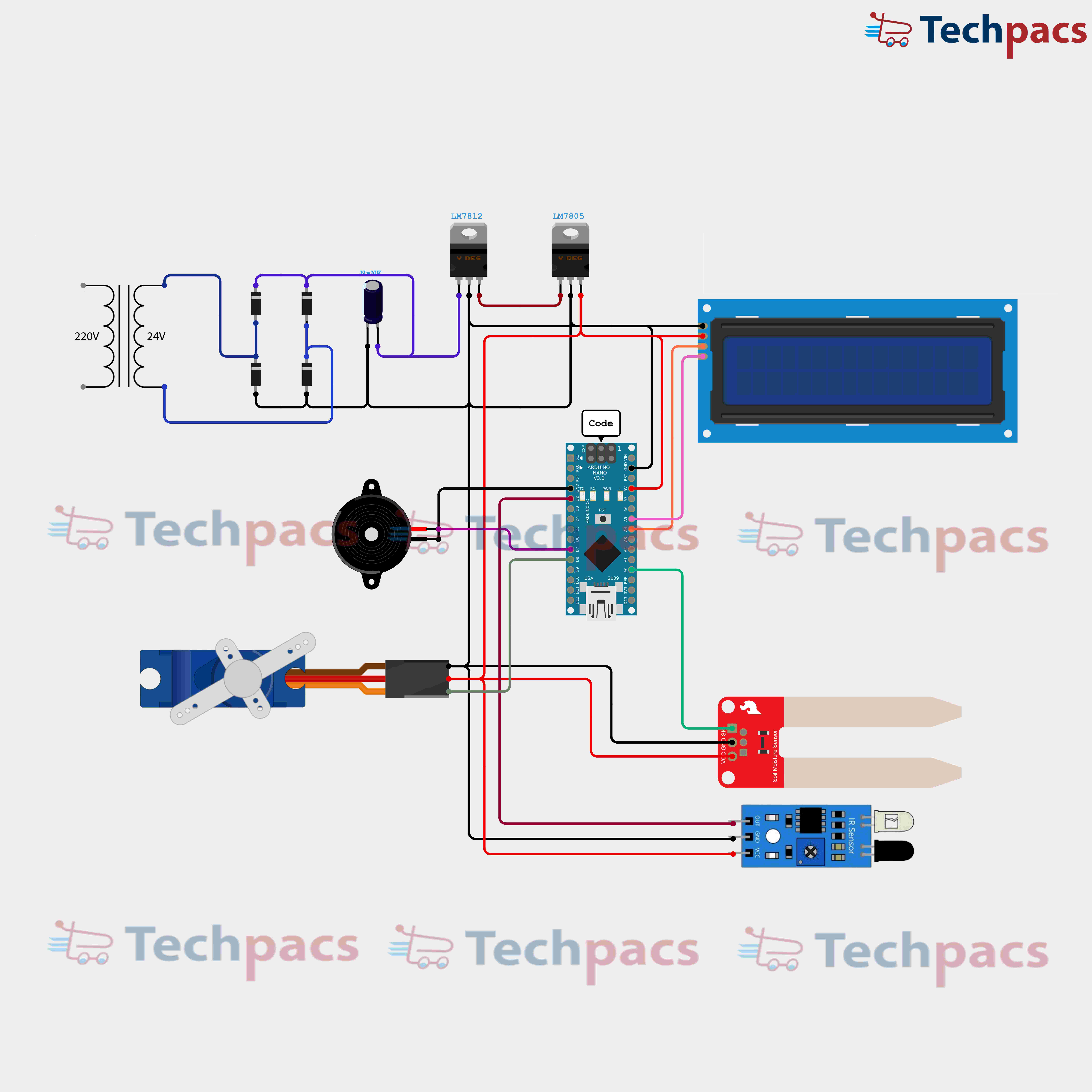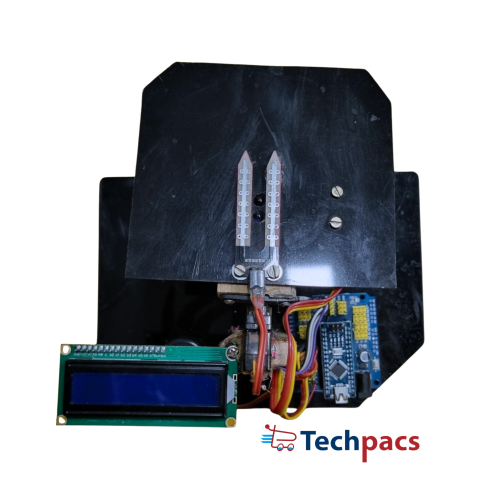Arduino-Based System for Automatic Waste Segregation
The Arduino-Based System for Automatic Waste Segregation is an innovative project aimed at automating the process of waste segregation using Arduino technology. This system utilizes various types of sensors to identify different kinds of waste and segregate them accordingly. By leveraging the power of automation, this project aims to make waste management more efficient and environmentally friendly. The system not only assists in reducing human effort but also ensures a higher accuracy rate in the segregation process, fostering a more sustainable environment.
Objectives
1. To design and implement an automatic waste segregation system using Arduino.
2. To utilize sensors for detecting and classifying different types of waste.
3. To increase efficiency in the waste management process by reducing manual effort.
4. To ensure higher accuracy in waste segregation for better recycling and disposal.
5. To contribute to environmental sustainability by promoting automated waste management practices.
Key Features
1. Integration with a variety of sensors for accurate waste identification.
2. Automated servo motor to direct waste into the appropriate bin.
3. User-friendly LCD display for system status and errors.
4. Energy-efficient design optimized for minimal power consumption.
5. Scalable system framework that can be expanded to accommodate additional waste categories.
Application Areas
The Arduino-Based System for Automatic Waste Segregation can transform various sectors by enhancing their waste management processes. In residential areas, it can significantly reduce household waste sorting efforts and improve recycling rates. It is ideal for commercial spaces such as offices and shopping malls, ensuring proper waste categorization, thereby lowering waste disposal costs. Additionally, educational institutions can benefit from this system by educating students and staff about sustainable practices. Furthermore, municipalities can deploy this solution in public places to promote a cleaner environment by automating waste segregation, thus supporting city-wide waste management initiatives.
Detailed Working of Arduino-Based System for Automatic Waste Segregation :
The Arduino-based system for automatic waste segregation represents an effective and innovative solution to address waste management issues. The heart of the circuit is the Arduino microcontroller, which processes signals from various sensors to sort the waste into distinct categories. Let's delve deeper into its working by analyzing the flow of data and power through its components.
Powering the system is a 220V AC source which is stepped down to 24V using a transformer. This voltage is further regulated to 5V using a voltage regulator circuit to ensure all components receive a stable power supply. The regulated power is then distributed to various components, including the Arduino board and peripheral sensors.
The primary control element is the Arduino board, positioned at the center of the circuit diagram. It receives inputs from multiple sensors, including a moisture sensor, an ultrasonic sensor, and a metal detector sensor. Each of these sensors has a specific role in detecting attributes of the waste, essential for the segregation process.
The moisture sensor is responsible for detecting wet waste. It consists of two probes that measure the electrical conductivity of the waste. When placed in wet waste, the conductivity increases, and the sensor sends a signal to the Arduino, indicating the presence of wet waste. The Arduino, upon receiving this signal, activates a signal output to an LCD display, informing the user of detected wet waste.
The ultrasonic sensor, situated alongside, measures the distance between the waste item and the sensor. It works by emitting ultrasonic waves and measuring the time it takes for the echoes to return. This data helps the Arduino determine whether an object is present within its sensing range. Once confirmed, the Arduino processes this information and forwards a command to the servo motor.
The servo motor, connected to the waste segregation chute, moves according to the signals received from the Arduino. Depending on the type of waste detected - wet, metallic, or dry - the servo motor directs the chute to the corresponding bin. This mechanical movement is crucial for the physical segregation of waste.
In addition to the moisture and ultrasonic sensors, the circuit also incorporates a metal detector. The metal detector is designed to identify metallic waste. When a metallic object is detected, the metal detector sends a signal to the Arduino. Similar to the moisture sensor, the Arduino processes this signal and sends corresponding outputs to the display and servo motor.
The LCD display plays an essential role in providing real-time feedback to the user. It displays the type of waste detected, guided by the signals processed by the Arduino. This visual feedback ensures the system is functioning correctly and allows users to monitor the segregation process.
Moreover, a buzzer is integrated into the circuit for auditory alerts. In events where specific conditions are met, such as error detection or completion of segregation, the buzzer activates to notify the user. This dual-feedback mechanism, comprising visual and auditory signals, enhances user interaction with the system.
Overall, the interplay of sensors, the Arduino board, actuators, and feedback components forms a cohesive waste segregation system. Every component works in tandem to ensure that waste is sorted accurately and efficiently. The Arduino-based system thus represents a significant step towards automating waste segregation, making the process more streamlined, reducing human intervention, and fostering a more sustainable approach to waste management.

Modules used to make Arduino-Based System for Automatic Waste Segregation:
1. Power Supply Module
The Power Supply Module provides the necessary power to all components of the system. It typically consists of a transformer to step down the voltage from 220V to 24V, a rectifier circuit to convert AC to DC, and a voltage regulator to ensure a stable output voltage. This module feeds power to the Arduino as well as other modules like sensors and actuators. Proper power management and regulation are crucial to ensure the system operates reliably and without interruptions.
2. Arduino Microcontroller Module
The Arduino Microcontroller is the brain of the system and coordinates all activities. It is responsible for reading data from various sensors, processing that data, making decisions based on predefined logic, and controlling actuators. The coding done in the Arduino Integrated Development Environment (IDE) is uploaded to the microcontroller to govern its behavior. In this case, it will read sensor inputs to determine the type of waste and then signal the actuators for appropriate action.
3. Sensor Module
The Sensor Module includes various sensors like the moisture sensor, metal detector sensor, and possibly others to identify different types of waste (e.g., wet, dry, metal). Each sensor converts physical characteristics into electrical signals which are then fed to the Arduino. For instance, a moisture sensor provides analog or digital signals that reflect the moisture content of the detected waste, while a metal sensor detects metallic objects.
4. Actuator Module
Actuators include devices like servos or motors used for sorting the waste into different bins. Based on the Arduino’s decision, signals are sent to the actuators to physically move waste to the appropriate bin. For instance, a servo motor can be programmed to rotate a specific angle to direct wet waste to one bin and dry waste to another. Proper calibration and control of these actuators are essential for precise operation.
5. Display Module
The Display Module, typically an LCD, provides a user interface to display the system's operation status, sensor readings, and other relevant data. It helps the user understand which type of waste is being processed and any errors or alerts that might occur. The Arduino sends the necessary data to be displayed, formatted appropriately for user readability.
6. Buzzer Module
The Buzzer Module can be used to provide audio alerts to the operator. It can alert for events like successful sorting, errors, or the completion of the process. The Arduino controls the buzzer, turning it on or off in response to specific events in the waste segregation process.
Components Used in Arduino-Based System for Automatic Waste Segregation :
Arduino Controller
Arduino Nano
The central microcontroller that coordinates all sensor inputs and actuator outputs for the system.
Sensors
Moisture Sensor
Detects the moisture level of the waste to distinguish between dry and wet waste.
Infrared (IR) Sensor
Helps in identifying the presence and type of waste based on reflectivity and proximity.
Actuator
Servo Motor
Responsible for moving and segregating the waste into different bins.
Display
16x2 LCD Display
Shows the current status of the system, including the type of waste detected and sorted.
Alerting System
Buzzer
Provides audio alerts for important notifications, such as when the bin is full or a specific waste type is detected.
Power Supply
AC to DC Power Adapter
Converts 220V AC to 24V DC to power the Arduino and other components.
Capacitors
Helps in smoothing out the fluctuations in the power supply ensuring stable operation of the system.
Voltage Regulator
Ensures that a constant voltage is supplied to the Arduino and other components, protecting them from voltage spikes.
Connectors and Wires
Jumper Wires
Used to connect various components to the Arduino and ensure proper signals are transmitted and received.
Breadboard
A platform for prototype development and testing circuit connections before final deployment.
Other Possible Projects Using this Project Kit:
1. Smart Irrigation System
A smart irrigation system automatically waters plants depending on the soil moisture levels. Utilizing the soil moisture sensor, the system can detect when the soil is dry and activate the water pump to irrigate the plants. This can be particularly useful in large gardens or farms where manual irrigation is impractical. The Arduino microcontroller processes the data from the soil moisture sensor and controls the relay to turn on or off the water pump accordingly. An LCD display can provide real-time data on soil moisture levels and water usage, making it easier for users to manage water resources efficiently.
2. Home Automation System
A home automation system can control various appliances such as lights, fans, and other devices based on sensor inputs and user commands. Using the Arduino microcontroller as the core, this system can be expanded by connecting additional sensors such as motion detectors, temperature sensors, and light sensors. The setup in the waste segregation project kit can be repurposed to manage different electrical devices, providing convenience and energy efficiency. With the integration of wireless communication modules, the system can also be controlled remotely via a smartphone application, giving users control over their home appliances from anywhere.
3. Smart Parking System
A smart parking system helps to manage and monitor the availability of parking spaces in real-time. By using ultrasonic sensors to detect whether a parking spot is occupied or vacant, the Arduino microcontroller can process this information and display it on an LCD screen. This system can also communicate this data to a central server or a smartphone app to provide real-time updates to users looking for parking. This project helps in managing parking efficiently in large parking areas and can reduce the time spent searching for available spaces, thereby saving fuel and reducing traffic congestion.
4. Automated Greenhouse Monitoring System
An automated greenhouse monitoring system ensures optimal growing conditions for plants by continuously monitoring temperature, humidity, and soil moisture levels. The Arduino microcontroller collects data from various sensors and controls relays to activate heaters, fans, and irrigation systems as needed. This project can provide real-time information on environmental conditions inside the greenhouse through an LCD display. Advanced versions of this system can be integrated with IoT platforms to allow remote monitoring and control via smartphones or computers, ensuring the plants receive the best possible care regardless of the user's location.
| Shipping Cost |
|
No reviews found!






































































No comments found for this product. Be the first to comment!